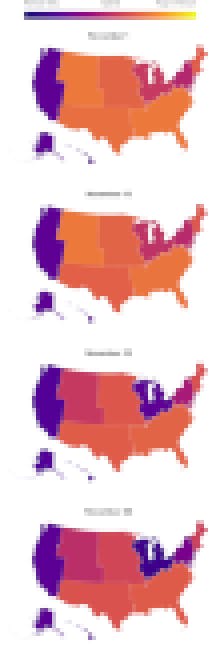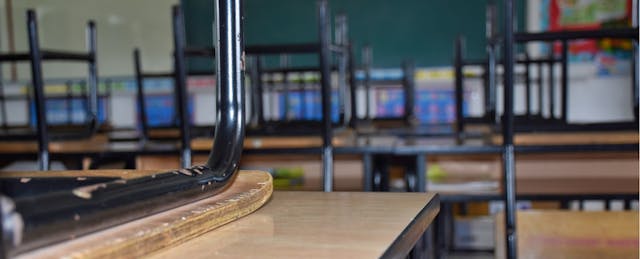In a grim year, the month of November was one of the grimmest for the United States. On Nov. 9, the country recorded its 10 millionth COVID-19 case, up from 9 million only ten days earlier. By month’s end, the 7-day rolling average of daily cases had doubled, from over 80,000 on Nov. 1 to more than 160,000 after Thanksgiving. The virus claimed lives at an alarming rate, with more than 2,000 daily deaths reported for the first time since the spring. And public health officials warned that the worst was still to come.
That scuttled hopes that students would be returning to classrooms en masse, as many districts based their reopening plans on local infection counts. After steadily moving toward offering attendance structures with some in-person component over the course of the fall, districts around the country turned back to only offering remote-learning during the month of November.
That’s a key finding from an EdSurge/Social Context Labs analysis of 375 school district reopening plans across all 50 states, Puerto Rico, and Washington D.C., representing a diversity of geographies, COVID-19 infection rates and poverty levels. On Nov. 1, 22 percent of districts in the sample only offered remote instruction. By the end of the month, 38 percent of districts did.
Among the districts in the sample, the percentage of students actually learning remotely is far higher. Even when an in-person option is available, all but a handful of districts offer the option to attend school remotely; in some cases, significant portions of the student body elect to participate in remote instruction. And large, urban districts that typically serve more students have been more likely to adopt remote-only learning than suburban and rural districts. At month’s end, 42 percent of urban districts in the sample offered remote-only instruction, while only 19 percent of rural districts did.
Variation in Attendance Structures by State
An overall trend toward remote-only instruction is only part of the story. The availability of fully in-person instruction or a hybrid model that combines in-person and remote instruction varies significantly by state and region. It also obscures the difference between attendance structures that are not fully remote.
To understand these trends, we examined the prevalence of remote-only, hybrid, and fully in-person attendance structures among districts in our sample in each state, Puerto Rico, and Washington, D.C., on four dates in November. For each state and date, we calculated a number between 0 to 1, where 0 indicates that all districts offer fully-remote instruction, and 1 indicates that all districts offer fully in-person instruction. Districts offering hybrid instruction without a fully in-person option fall in the middle.

The results from our analysis confirm some trends that are unsurprising. Districts in South Dakota—whose governor has declined to implement COVID-19 restrictions amid a worsening crisis—have continued to offer fully in-person instruction throughout the month of November. Districts in California, where COVID-19-related restrictions have been more expansive than in many places, have largely remained remote-only. (Our analysis also shows that Hawaii and Puerto Rico only offered remote learning through November, but in both cases there is only one district that makes the call.)
The analysis also reveals some surprising trends, particularly when it comes to understanding scores that are in the middle between remote-only and fully in-person instruction on our scale. In some cases, as in Vermont, this reflects the dominance of a hybrid attendance structure among all the districts in our sample.
In other cases, a score in the middle of the spectrum reflects a mix of remote-only and fully in-person districts within the state. That is the case in Missouri, where state directives are limited and districts have leeway in choosing their attendance structures.
One Week in November
Starting mid-November, districts began to move away from fully in-person and toward remote-only instruction. In Kentucky and Michigan, these changes were directed by state-level leaders. In most other cases, they came in response to worsening COVID-19 case counts and fear of spread around the Thanksgiving holiday.
Between Nov. 15 and 22, the following states saw the largest move toward remote-only instruction: Michigan, Colorado, West Virginia, Wisconsin, Montana, Wyoming and Illinois.
The shift between Nov. 15 and Nov. 22 is also visible regionally, when a single attendance structure score is calculated for all the districts in a single region on each date. (See regional maps below.) The Great Lakes and the Rocky Mountain regions showed the greatest movement toward only offering remote instruction in that week.

Between Nov. 22 and Nov. 30, the Mideast region followed with many districts shifting toward remote-only instruction. Notably, the Far West remained steady in predominately offering remote-only instruction throughout the month (as it has for most of the year since the pandemic began).
An EdSurge analysis earlier this fall found districts in states with higher COVID-19 positivity rates were more likely to offer school with some in-person component. But as infections flared up everywhere during November, most of the country is trending toward remote-only instruction, even as variation exists within states and between regions. Whether that continues into the new year will likely depend on whether spiraling COVID-19 case counts can be brought under control, and how quickly vaccinations will make their way into schools.


